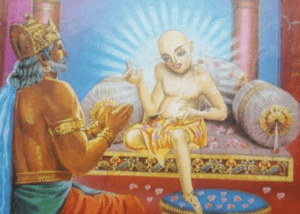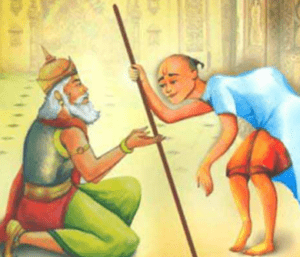The Timeless Wisdom of the Ashtavakra Gita: A Journey into Self-Realization
Introduction
Historical Context and Authorship
Ashtavakra Gita: An Overview
The Story Behind Ashtavakra Gita

A Translator’s Perspective

The Journey Begins:
In the ancient kingdom of Mithila, renowned for its lush landscapes and thriving culture, there ruled a wise and just king named Janaka. Despite his immense wealth and power, Janaka was plagued by a deep existential yearning—a longing for ultimate truth and liberation. His court was frequented by the greatest minds and sages of his time, yet none could quench his thirst for spiritual knowledge.
One day, word reached Janaka of a particular sage named Ashtavakra. Born with eight deformities, Ashtavakra was often shunned and mocked by society. Yet, his physical appearance belied a profound spiritual wisdom. Intrigued, Janaka invited the sage to his court, hoping that he might find the answers he sought.
Ashtavakra arrived, his crooked body a stark contrast to the regal splendour of Janaka’s palace. The courtiers sneered, but Janaka welcomed him with reverence. Seated on a simple mat, Ashtavakra began his discourse.
“Great King,” Ashtavakra began, “to attain Knowledge, detachment, and liberation, one must understand the true nature of the Self. The world you perceive is an illusion, a mirage that ensnares the ignorant. You are already unbound, actionless, and pure. It is your mind, with its constant churning and attachment to the unreal, that binds you.”
Janaka listened intently, the words resonating deeply within him. Ashtavakra’s teachings were unlike anything he had heard before. They did not dwell on rituals, duties, or morality, but pointed directly to the nature of the Self and the illusory nature of the external world.
As Ashtavakra spoke, a deep transformation began within Janaka. The layers of ignorance and attachment that had clouded his vision for so long started to peel away. He realized the truth of Ashtavakra’s words—that he was indeed unbound and pure, beyond the transient world of forms and names.
With this revelation, Janaka described his new state of being. “Oh Sage, I feel joy and wonder unlike any other. The world appears as a play of shadows, and I stand apart, a witness to its unfolding. I see now that I am the Self—eternal, formless, and free.”
Ashtavakra smiled, sensing the depth of Janaka’s realization. Yet, he knew that the journey was not complete. The initial burst of enlightenment, while powerful, needed to be deepened and solidified.
Ashtavakra’s next words were a test of Janaka’s newfound wisdom. “Great King,” he said, “while you speak of your realization, I see traces of attachment lingering. You still find pleasure in the play of the world, and this binds you. True liberation comes when one is free from all desires, however subtle.”
Janaka, unperturbed, replied, “O Sage, the Lord of the Universe can do as he pleases. What harm is there in enjoying the world while knowing it to be an illusion?”
Ashtavakra did not disagree but pressed further, pointing to the next step—dissolution of the ego. “You must go beyond even this enjoyment, King Janaka. The Self is complete in itself, needing nothing from the world. True detachment is not just in action, but in the heart and mind.”
Janaka, now more confident in his understanding, matched Ashtavakra’s challenge. “I know that already, revered Sage. My actions are but a reflection of the play of consciousness. The world cannot bind me, for I am the Self—untouched by its transient nature.”
Ashtavakra nodded, recognizing Janaka’s progress. “Indeed, you have grasped the essence. But remember, the ego can be deceptive. It can disguise itself in the garb of enlightenment. One must be ever vigilant, dissolving all traces of ‘I’ and ‘mine’.”
Despite Janaka’s assertion, Ashtavakra sensed a lingering sense of self in his words. He delved deeper into the subtleties of attachment and bondage. “King Janaka, the wise see the Self in everything and everything in the Self. They are free from distinctions and dualities. But as long as there is a ‘you’ enjoying the play, there is still separation. True liberation is the dissolution of all dualities.”
Janaka contemplated Ashtavakra’s words, realizing the truth they held. The sense of a separate self, even in its subtlest form, was a barrier to complete liberation. He resolved to dissolve this last vestige of ego and embrace the vast emptiness of the Self.
As Janaka continued to reflect and meditate on Ashtavakra’s teachings, a stillness settled within him. He no longer saw himself as a separate entity but as a part of the infinite consciousness. The joys and sorrows of the world touched him no more.
In a calm and serene voice, Janaka described his state to Ashtavakra. “O Sage, I stand in timeless stillness, untouched by the play of forms. I see the world as a mirage, a dance of shadows. My true nature is pure, formless awareness, beyond all dualities.”
Ashtavakra smiled, pleased with Janaka’s progress. “You have indeed come far, O King. Your understanding is deep and true. But remember, the journey of self-realization is endless. One must continually dissolve the ego and remain in the awareness of the Self.”
As their dialogue continued, Ashtavakra and Janaka dug deeper into the nature of desirelessness, the futility of effort, and the meaning of true freedom. Ashtavakra’s teachings were relentless, stripping away every last trace of ego and attachment.
Finally, Ashtavakra voiced a barrage of pure non-dual wisdom—one hundred verses that left no room for doubt or duality. His words were like a cleansing fire, burning away the last remnants of Janaka’s ego.
In the silence that followed, Janaka could no longer describe his state. He spoke only in questions, revealing the complete absence of a separate self. The king had entered the state of dissolution, where all distinctions and dualities ceased to exist.
In the final chapter of their dialogue, Janaka’s questions pointed to the meaninglessness of all concepts and distinctions. He had reached a state of pure awareness, beyond all words and descriptions.
“No more can be said,” he declared, signalling the end of his journey.
Ashtavakra smiled and nodded approvingly. The sage had led his disciple to the ultimate truth, and now there was nothing more to teach.
The Legacy of the Ashtavakra Gita
Ashtavakra Gita is one of the treasure troves in the spiritual wisdom of ancient India. It offers a radical vision of non-duality, challenging the seeker to look beyond the illusions of the world and realize the true nature of the Self.
Unlike many other spiritual texts, the Ashtavakra Gita does not dwell on rituals, morality, or duties. Instead, it points directly to the nature of reality and the path to liberation. It is a text of immense purity and power, capable of triggering self-realization in those who are ripe for its teachings.
For centuries, the Ashtavakra Gita has inspired countless seekers on their spiritual journey. Its teachings are timeless, offering a path to liberation that is as relevant today as it was in ancient times.
In the words of Bart Marshall, the translator of the Ashtavakra Gita, “Every word is aimed at triggering Self-realization—no suggestions for self-improvement, no rules for moral behaviour, no practical wisdom for daily life. Pure, because it is relentlessly one-pointed. Powerful, because the mere reading—or repeated reading—of it can be enough to send a ripe mind reeling into Truth.”
Conclusion:A Journey Beyond Words
The story of King Janaka and Sage Ashtavakra is more than just a dialogue between a guru and his disciple. It is a journey into the depths of the self, a path to the ultimate truth that lies beyond all words and concepts.
Ashtavakra’s teachings remind us that true liberation comes not from external achievements or rituals, but from the realization of our true nature. It is a journey of self-discovery, a path that requires us to look beyond the illusions of the world and embrace the vast emptiness of the Self.
For those who are ready, the Ashtavakra Gita offers a direct path to liberation. It challenges us to dissolve the ego, take up desirelessness, and realize the pure, formless awareness that is our true nature.
In the end, the journey of self-realization is a personal one, unique to each seeker. But the teachings of the Ashtavakra Gita offer a timeless guide, pointing the way to the ultimate truth that lies within us all.
May the wisdom of Ashtavakra and the journey of King Janaka inspire you on your path to self-realization. And may you find the peace, joy, and liberation that lies beyond all illusions, in the timeless stillness of the Self.
what we offer
Explore Our Top Yoga Programs in Kerala

200H Yoga Teacher Training in Kerala
View Program

300H Yoga Teacher Training in Kerala
View Program

Yoga & Ayurveda Retreats
Shorter immersive retreats in Kerala combining yoga, Ayurveda, and meditation. Reconnect with yourself while experiencing India’s holistic traditions.
View Program
